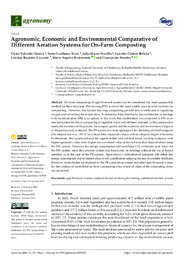Title:
Agronomic, Economic and Environmental Comparative of Different Aeration Systems for On-Farm Composting |
Authors:
Valverde Orozco, Víctor Hugo 
Gavilanes Terán, Irene 
Idrovo Novillo, Julio César 
Carrera Beltrán, Lourdes Cumandá 
Basantes-Cascante, Cristian
Bustamante, Maria Angeles 
Paredes, Concepcion  |
Editor:
MPDI |
Department:
Departamentos de la UMH::Agroquímica y Medio Ambiente |
Issue Date:
2023-03-21 |
URI:
https://hdl.handle.net/11000/31016 |
Abstract:
On-farm composting of agro-livestock wastes can be considered the most appropriate method for their recycling. Pile turning (PW) is one of the most widely used aeration systems for composting. However, this system has long composting periods and is inefficient at supplying oxygen and controlling the temperature. To minimize these drawbacks, the combination of turnings with forced aeration (PR) is an option; in this work, this combination was compared to PW as an aeration system for the co-composting of vegetable waste with different manures. In this comparative study, the evolution of the process, the compost quality and the economic and environmental impacts of the process were evaluated. The PR system was more appropriate for obtaining sanitized composts (the temperature was ≥55 °C for at least three consecutive days) with an adequate degree of maturity. Furthermore, this system reduced the organic matter and nutrient losses, yielding composts with higher agronomic value and a higher total combined value of the nutrients than those obtained using the PW system. However, the energy consumption and associated CO2 emissions were lower for the PW system, since this aeration system was based only on turnings without the use of forced aeration, as in the case of the PR system. Agricultural valorization of composts will offset this energy consumption and its impact, since it will contribute to reducing the use of synthetic fertilizers. However, more studies are required on the PR composting system and other agro-livestock wastes for the creation of centralized on-farm composting sites, where all steps of the composting chain are optimized
|
Keywords/Subjects:
Agro-livestock wastes
Compost
Forced aeration
Pile turning
Combined aeration system |
Type of document:
application/pdf |
Access rights:
info:eu-repo/semantics/openAccess
Attribution-NonCommercial-NoDerivatives 4.0 Internacional |
DOI:
https://doi.org/10.3390/agronomy13030929 |
Appears in Collections:
Artículos Agroquímica y Medio Ambiente
|

.png)
